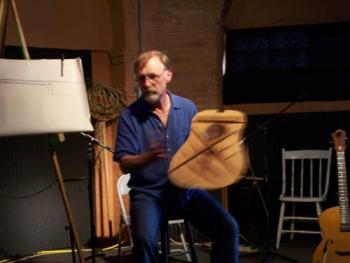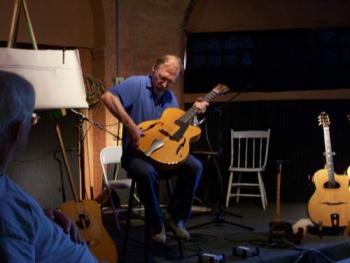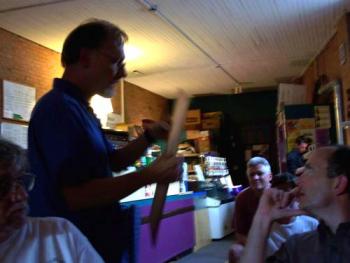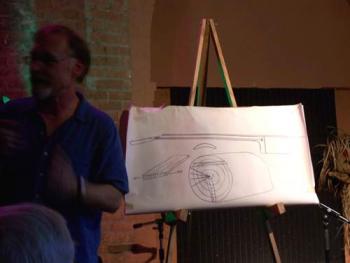Luthier Bernie Lehmann Talks Guitars (July 9, 2007)

Bernie Lehmann
This meeting featured an interesting change in perspective. Instead of discussing the music we produce on the guitar and the technique used to produce it, Bernie Lehmann, an experienced local luthier, spoke about the instrument itself, how it is constructed and how it produces the sounds we are looking for, and the differences among the various types of guitar as well as how to set up and maintain the instrument.
Every part of a guitar contributes to the sound in some way. A guitar is essentially a mechanical amplifier designed to amplify the sounds produced by vibrating strings set in motion by fingers or picks. The strings transmit the vibrations to the body through the bridge. The body is essentially a box which acts as an air pump. The thickness of the guitar face may vary from outside to inside to act like a speaker cone. Guitars normally have bracing inside although the various types of guitars are braced in a variety of patterns depending on the type of guitar and the luthier. Lutes were braced laterally while guitars have more variety in bracing.

The material from which a guitar is built also affects the tone. Rosewood usually has more overtones than mahogany. Tops are typically made of spruce while a rigid maple neck diverts energy to the bridge. A rigid body and light top produce more volume similar to a banjo. Repeated washing of the original logs removes minerals similar to the natural aging of wood. The two matching pieces for the top come from two adjacent pieces on the original log. The top is cut vertically from the tree for even grain and even drying. Bernie passed around a number of wood samples to demonstrate the ringing quality that they produce when struck with the knuckles and the variety of sound quality from one piece to another.
Bridge pins, as well as saddle and nut are best when made from bone or tusk. A higher saddle produces more volume. Treble strings are closer to the neck than bass strings since the range of motion is less. The bass strings are slightly longer since they stretch more. This is reflected in an angled bridge. On classical guitars this difference is negligible and the bridge is straight.

Some manufacturers take a very technological approach to guitar making. But guitar making is an art as well as a science. Individual luthiers like Bernie are constantly experimenting with new materials and techniques. The results are discovered in the actual production. He personally likes to introduce asymmetry into many aspects of guitar making including bracing to achieve a more natural sound. He generally places braces closer on the treble side and farther apart on the bass side to match the nature of sound waves.
Rooms also exhibit qualities similar to instruments, the material, size and shape of the room affecting the ultimate sound. The furnishings and people present also affect the overall sound produced. As in the instrument, asymmetry produces more natural complex sounds.
Guitar design is still evolving unlike violin making which has been largely perfected. Guitars are not easily taken apart for repairs as are violins. As a result, we do not usually find guitars of the same age and sophistication as violins.

There are many variations on a theme, the main types of acoustic guitar being flattop and arch top. The flattop includes acoustic and classical guitars. The gypsy guitar combines features of both the flattop and the arch top. The flattop has a fixed bridge, a round sound hole, and the strings are connected to the bridge. The arch top, in contrast, has a floating bridge, F holes, and the strings are connected to a tailpiece first passing over the bridge resulting in very strong projection. A gypsy guitar is similar to a flattop, but with a tailpiece and a very light construction. A gypsy guitar is designed to produce loud chords with a rasqueado technique to accompany dancing, and buzzing is considered acceptable, perhaps desirable.
Some guitar makers use modern technology and theories to produce consistent instruments. A good example is Taylor. Other makers use a more intuitive approach squeezing the wood with the thumb, tapping and listening to achieve the desired sound. This produces more variety in individual instruments.
One modern technique is the addition of a hole on the top side of the instrument so that the player can hear the music the way the listener does. Some would say that this technique improves the overall projection. Another modern approach to guitar construction is the use of double tops or backs to create more projection. This technique eliminates the need for bracing.
A new guitar with a truss rod requires some adjustment. A truss rod through the neck of a guitar adjusts the bow of the neck in order to control the action of the strings. The strings should be slightly higher halfway down the neck. Much of the adjustment necessary depends on the individual style of playing, i.e., finger picking, flatpicking, aggressive or light attack. A typical setup is relatively inexpensive. Fret levelling may eventually be required since frets tend to wear down being softer than strings. The frets can also be replaced. Guitars are optimally kept in an environment similar to that in which they were made with the humidity ideally between 40 and 60%.
Bernie concluded his interesting and informative discussion by playing for us on one of his own instruments.
— R. Taglieri, photos by K. Nelson
Share this page: ![]() Facebook
Facebook
![]() Del.icio.us
Del.icio.us
![]() StumbleUpon
StumbleUpon
![]() Digg
Digg
![]() Reddit
Reddit
Home ::
About Us ::
Events ::
Articles ::
Resources ::
Contact Us ::
Links
©2007-2008, Rochester Guitar Club, All Rights Reserved, This page last updated 2010-02-27 11:24:28
Website by Red Beagle Web Development.








